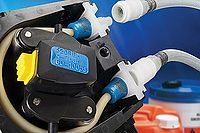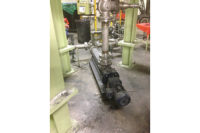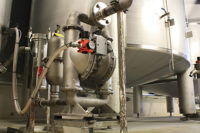A simple solution for metering corrosive chemicals.
Hydrochloric acid, sodium hydroxide, sodium hypochlorite, sulfuric acid - these are just a few samples of the chemicals used throughout the world in many industries. They are also chemicals that can shut down processes due to pump failures. When faced with the challenge of installing a mechanical pump in the heart of their process to meter aggressive chemicals, engineers must juggle three complex problems: 1) finding a pump that can withstand their chemicals and run reliably; 2) finding a pump that accurately meters to optimize chemical usage and product yield; and 3) finding a pump that is quick and simple to maintain and operate. Increasingly, process engineers are turning to peristaltic pumps to solve all three problems, reducing lifecycle costs and driving gains in process efficiency.

Principle of Peristaltic Pump Operation
Peristaltic pumping is the fastest-growing pump technology in the world, displacing more complex and higher maintenance positive-displacement (PD) pumps for chemical metering. Acids, caustics and solvents attack the valves, seals, stators, and moving parts of diaphragm and progressive cavity pumps, the two most commonly used PD pump types, causing disruptive downtime and increasing lifecycle costs. By contrast, the peristaltic principle allows engineers to mitigate these costs. Peristaltic pumps are inherently valve- and seal-less, and have no mechanical parts in the product stream. Fluid only comes into contact with the inside of a hose or tube element, which is a low-cost, low-maintenance and easily serviceable component.
Based on the physiological principle of “peristalsis,” a term referring to the alternating contraction and relaxation of muscles around a tube (e.g., throat or intestines) to induce flow within it, a peristaltic pump’s operation is elegantly simple. A hose or tube element is positioned along a stationary pump housing and is compressed from the outside by a roller (tube pump) or a shoe (hose pump) (see Figure 1). Fluid is pushed toward the discharge as the roller or shoe moves along the outside of the element, while the restitution of the hose or tube element behind the shoe draws more fluid into the pump. The heart of the pump is a hose or tube, which is available in different elastomers specifically formulated to balance long mechanical pumping life with resistance against concentrated acids, bases and solvents. The “wetted end” simplicity of a peristaltic pump stands in contrast to the complexity of a diaphragm pump, where one must properly select materials for the pump housing, diaphragm, ball checks and seals to prevent pump failure from corrosive attack.
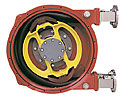
High-Accuracy Metering
Positive-displacement pumps are normally chosen to accurately meter or dose exact amounts of chemicals. In a peristaltic pump, flow is proportional to pump speed, and the complete closure of the hose or tube element at all times (see Figure 2) gives the pump its positive displacement action, preventing flow drop or erosion from backflow, and eliminating the need for check valves. Without check valves, peristaltic pumps eliminate the primary source of metering inaccuracy and will not vapor-lock.
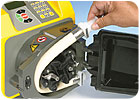
Diaphragm pumps have internal valves that can stick, clog and not seat correctly (due to corrosion of the ball or seat), causing variation in flow that can jeopardize the integrity of the finished product, or cause inconsistencies in product quality. In addition, chemicals that have entrained gases like sodium hypochlorite can vapor-lock diaphragm pumps, completely stopping flow.
The “turndown ratio” or “flow range” of a peristaltic pump is unparalleled. A high-quality peristaltic pump is capable of over 2000:1 flow range (max flow to min flow) by simply controlling one parameter - the rotor speed. With the added versatility of putting different tube sizes into one pump, the flow range expands to 1 million:1 range with a single pump. Diaphragm pumps are normally limited to 20:1 speed range with typical controllers. Although diaphragm stroke length can also be adjusted to increase flow range, short stroke lengths decrease metering accuracy tremendously. When wide flow ranges are required, two more diaphragm pumps are commonly required to manage the flow requirement that a single peristaltic pump can cover.
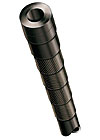
Lowest Lifecycle Costs
While the initial capital cost of a peristaltic pump can be slightly higher than other PD pumps, an assessment of costs associated with ancillary items, installation, maintenance downtime and spare parts quickly tip the lifecycle cost calculation in favor of the peristaltic pump, often significantly.
With the tube or hose element being the only wetted part, peristaltic pumps are virtually maintenance free, with no expensive seals to replace, no check valves to clog, and no rotors and stators to wear out. In a peristaltic pump, the hose or tube element needs periodic replacement. Industrial-duty peristaltic pumps will provide thousands of hours of reliable and repeatable hose or tube life before the element fatigues and needs replacement. When it comes time to replace a hose or tube element (see Figure 4), the procedure takes less than an hour and sometimes only a few minutes. In addition, the change of the element is done quickly and safely right where the pump sits without the need for any special tools. This is significantly less than the 4-6 hours typically required for rebuilding a diaphragm or progressive cavity pump (which does not include the additional time for pump removal, transit to and from the maintenance shop and reinstallation.) Replacement hose and tube element costs are extremely economical compared to rebuilding a diaphragm or progressive-cavity pump, where wetted end replacement parts like ball valves, rotors and stators can cost up to 75% of the pump’s initial purchase price.
Peristaltic pumps also do not require the installation and maintenance of ancillary equipment commonly used with other pumps. Diaphragm pumps require artificial backpressure valves and degassing valves for proper operation of their internal check valves. Progressive-cavity pumps often need double mechanical seals, seal-water flush systems, run-dry protection and in-line check valves. The cost of these ancillary items is eliminated when installing a peristaltic pump.
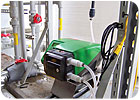
Process control requirements and chemical compatibility often make peristaltic pumps a lower-cost capital item than other PD pumps, delivering financial benefit even before the reduction in maintenance and ancillary costs is considered. For example, a progressive-cavity pump’s price can be exponentially inflated when expensive metallurgy becomes the only corrosion-proof option for the rotor, housing and wetted drive-rod components. In addition, many PD pumps require the additional cost of a separate control panel or variable frequency drive (VFD) for achieving variable-flow metering, with incremental cost and complexity if high turndown is required. Peristaltic pump manufacturers, however, usually build high turndown, closed-loop speed-control capability and expansive I/O connections for DCS and SCADA systems into their off-the-shelf pumps (see Figure 5). This standard turnkey solution simplifies mechanical, electrical and instrumentation integration.
Other Advantages
Peristaltic pumps have the ability to self-prime and dry-prime (up to 30 feet), which improves employee safety by reducing the handling of hazardous chemicals. Peristaltic pumps can also run dry indefinitely without damage, making them the ideal PD pump for tank emptying or other unassisted applications that may require the pump to periodically run with little or no fluid entering the pump. Peristaltic pumps are completely reversible, so a simple change in direction can be used to drain lines or dislodge line blockages.

Chemical Applications
In industrial-chemical metering applications, past history has given diaphragm and progressive-cavity pumps a leg up on peristaltic pumps in terms of product awareness and market penetration. Historically, the fundamental barrier to applying peristaltic pumps to heavy-duty chemical applications was a technological limitation in hose or tube design that could withstand highly corrosive fluids while yielding long life at continuously high pressures and flow rates. For this reason, peristaltic pumps found their niche in low-pressure batch pharmaceutical processes, with limited use in industrial processes. This has changed over the past 50 years, however. Companies like Watson-Marlow Bredel Pumps have developed pumps and chemical duty elements capable of over 350 gpm, 240 psi, thousands of hours of continuous duty hose and tube life, and metering accuracy better than 0.5%. Peristaltic pumps are now installed around the world, widely used for transferring and metering the toughest corrosive chemicals across a variety of industries, including petrochemical, paints and pigments, pulp and paper, food processing, mining, water, and wastewater treatment.
Peristaltic pumps have proven to be highly resistant to the acid and caustic chemicals that quickly eat away at the metallic components of progressive cavity and diaphragm pumps. For example, Watson-Marlow Bredel has engineered a number of pumps designed to withstand the high viscosity and abrasive nature of certain coatings. For flock adhesive and slip agents for door or window molding, dispensing silk-screening ink, or lapping compounds for gear set manufacturing, the 520 pumps handle coatings very gently with no agitation or emulsification, ensuring the properties of the product will not change. The product never touches the pump (and vice versa), so there is no abrasive wear on the pump. Further, for accurate metering and dosing of corrosive, abrasive and viscous epoxies, the 620 pump provides unrivaled performance with a speed range of 2650:1.
In the manufacturing world, an engineered plastics manufacturing plant in the Southeast uses a SPX10 pump from Watson-Marlow Bredel (see Figure 6) with a long-lasting rubber hose to precisely meter hydrochloric acid in the production of linear polyphenylene sulfide (PPS). Because of the hose pump’s metering capability, the plastics manufacturer does not require separate flow meters and valves to measure and control the flow. Rather, they adjust the speed of the feed rate by simply altering the RPM of the rotor motor with a variable frequency drive.
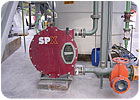
This manufacturer chose peristaltic pumps because the aggressive chemicals do not make contact with any metal parts. Likewise, water and wastewater-treatment facilities often use hose pumps for ferric chloride, which is not only a coagulant in treating sewage and drinking water, but is also a highly corrosive chemical used for etching metals, including copper and stainless steel.
A power generation servicing company in the mid-Atlantic region uses peristaltic pumps to meter 65 gpm of sulfuric acid when cleaning out the condensers of a power plant, driving the pH down to below 4.0 to breakdown scale. Precise control of the acid’s flow is necessary to ensure that, after the scale is dissolved, the discharge to the municipal wastewater system will have a neutral pH.
On the other side of the pH scale, peristaltic pumps are used extensively with sodium hydroxide for many different applications, such as bleaching pulp at paper mills and disinfecting potable water. Because the hose in a peristaltic pump is self-cleaning, it does not experience the crystallization that builds up in other pumps and eats away at seals.
Until recently, petrochemicals, hydrocarbons and oil-based products were all beyond the reach of peristaltic pumps due to incompatibility with the rubber hose. A new TPE (thermoplastic elastomer) hose called PetroProof is now available for toluene and other highly corrosive solvents used in the production of materials such as gaskets, adhesives, printing ink, aerosol spray, wall paints, lacquers, cosmetics and more.

Frequently, corrosive fluids contain both corrosive chemicals and abrasive material. Peristaltic pumps, originally designed for caustic and abrasive cement applications, stand up well to the challenge. A southeastern U.S. building products manufacturing plant uses Watson-Marlow Bredel peristaltic pumps in the manufacturing of its fiber cement siding products. The cement mixture has little effect on the hose despite being highly abrasive and strongly basic (pH of 12-13).

Peristaltic pumps are also used for other corrosive and abrasive fluids, including lime slurry and underflow in mining operations (see Figure 8), alum in wastewater treatment (see Figure 9), and titanium dioxide for pigmented inks and paints.
In contrast to peristaltic pumps, the combination of corrosion and abrasion takes a toll on other PD pumps. In diaphragm pumps, corrosive and abrasive fluids inevitably cause erosion or clogging of the valves, requiring frequent rebuilds of the pump’s wetted end. Progressive cavity pumps move fluid along the successive cavities formed between the meshing of a fixed stator and rotating rotor. Erosion from abrasive fluids widens clearances between the rotor and stator, causing internal slip. This requires the user to speed up the pump in order to maintain capacity and/or metering accuracy, accelerating wear until rotor and stator need to be replaced, normally four stators to every rotor replacement.
With diaphragm and progressive-cavity pumps, abrasive fluids can cause problems beyond the normal wetted end of the pump. For example, in a progressive-cavity pump, it is only a matter of time until universal joint (gear or pin type) seals fail, allowing abrasive slurry to erode the numerous parts within each joint, including the ends of the connecting rod.
Despite all of the advantages of using peristaltic pumps for corrosive chemicals, they represent a modest but continually growing percentage of the positive-displacement pump market in the United States. This is primarily because peristaltic technology is relatively new in the U.S. market, whereas diaphragm and progressive-cavity pumps have a lengthy history. However, with pressure on plant managers to reduce the lifecycle costs of their pumps, the functionality and benefits of peristaltic hose pumps are becoming more widely known, and new peristaltic technology is fast becoming the PD pump of choice for chemically aggressive and abrasive applications.
For more information on pumps, visit www.watson-marlow.com.
